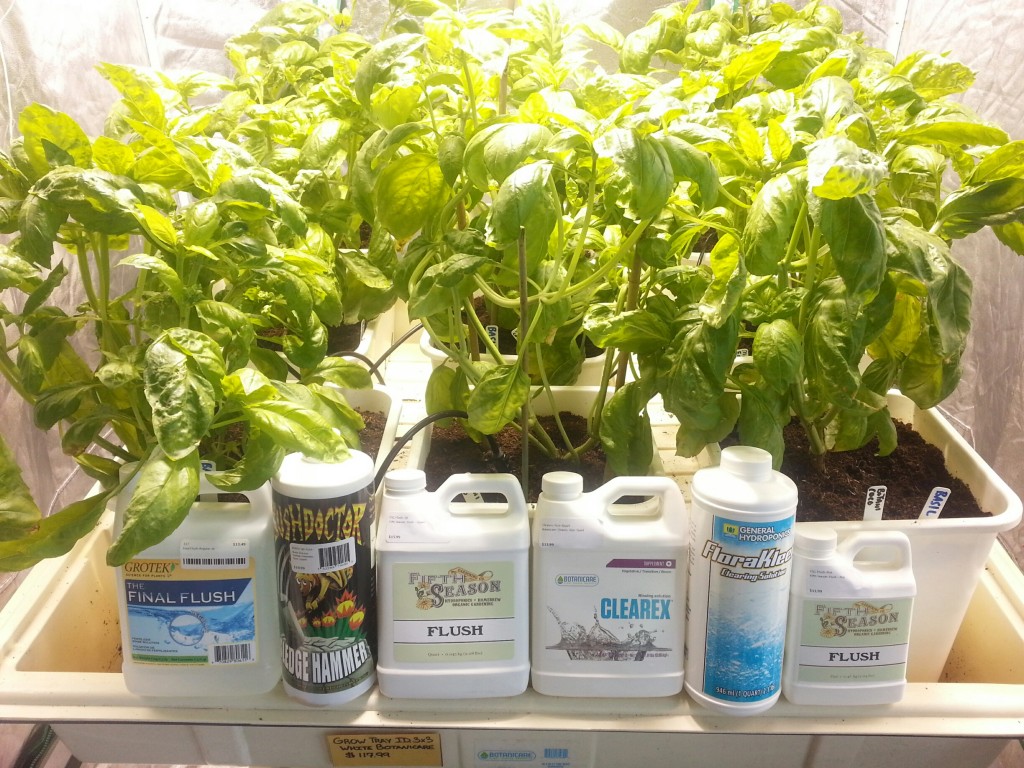 Flushing is often regarded as something that should be done at the end of your plant’s life cycle before harvesting. In reality, flushing has three major roles that benefit both the plants and you, the gardener, throughout the whole growth cycle.
Flushing is often regarded as something that should be done at the end of your plant’s life cycle before harvesting. In reality, flushing has three major roles that benefit both the plants and you, the gardener, throughout the whole growth cycle.
Flushing:
1) Keeps the growing medium and reservoirs clean
2) Keeps root zones and plants happy and healthy
3) Improves taste and aroma by removing excess chemicals and nutrients from plant tissue
Flushing regularly (up to every 7-10 days) removes fertilizer residues and salt build-ups that accumulate over time in both hydroponic systems and potting soils.
Flushing regularly is one of the best (and easiest) methods of keeping your pump, pipes, containers, and other system parts from accumulating excess mineral salts, dirt, and other debris. This not only keeps things clean and running during your growth cycle (how are those drip emitters and spray nozzles looking?), but also ensures healthy lifespans for your system’s parts, saving time and money.
Ever noticed a white crust on your soil, Hydroton, or Rocks? Flushing regularly during your grow can dramatically reduce the time spent cleaning and sanitizing for your next generation of plants.
Roots to Leaves:
Plants use water quickly and at a much faster rate than nutrients.
Excessive amounts of fertilizer in the medium can lead to soluble salt burn, which is the result of damage to the roots by dehydration*
Salt burn can result in:
– Dangerous conditions for the plant especially in high temperatures or growing conditions when the plants require more water
– The invasion of pathogenic fungi and rot (remember, they take advantage of stressed plants!)
– Brown spots on many of the leaves and edges that generally begin to curl down at the tips
– General nutrient deficiencies including discolored leaves, stunted plants and wilted or dead leaves
*Note: High salt concentrations that don’t even directly touch your roots can reduce the roots’ ability to take up water as the water will naturally move “away from the root toward the higher osmotic potential (salty) area…” (http://edis.ifas.ufl.edu/cv265)
Taste Test:
In its final ripening stages, a plant predominately uses up the remaining nutrients it has stored throughout its life. If the plant doesn’t use all the chemicals it has stored then taste-conscious gardeners may describe the fruits as having a bitter, chemical taste that a salt build-up can cause.
To combat this, gardeners can rinse the nutrient solution from the plants by flushing the system seven to ten days before harvest.
Control:
 Topping off the reservoir with pH balanced water can help keep the solution relatively well balanced for a week or so and salt build-ups can be controlled by monitoring EC levels. However, “even though EC might be maintained, the concentrations of specific nutrients cannot be determined.” (http://edis.ifas.ufl.edu/cv265)
Topping off the reservoir with pH balanced water can help keep the solution relatively well balanced for a week or so and salt build-ups can be controlled by monitoring EC levels. However, “even though EC might be maintained, the concentrations of specific nutrients cannot be determined.” (http://edis.ifas.ufl.edu/cv265)
Therefore, it is crucial that the reservoir be flushed once every 7 to 10 days and new solution formulated so that the original nutrient concentrations can be restored. These weekly change-outs are the perfect time to flush.
Flushing agents (like FSG Flush, Final Phase, Clearex, Flora Kleen, Final Flush, and Sledgehammer) actually rinse more excess salts and chemicals from the plants and systems than just plain water. Using them is as simple as emptying the reservoir, mixing up a solution of fresh water and your chosen flushing agent, and letting the system run for a couple of hours before rinsing and refilling with a fresh nutrient solution.

Leave a Reply